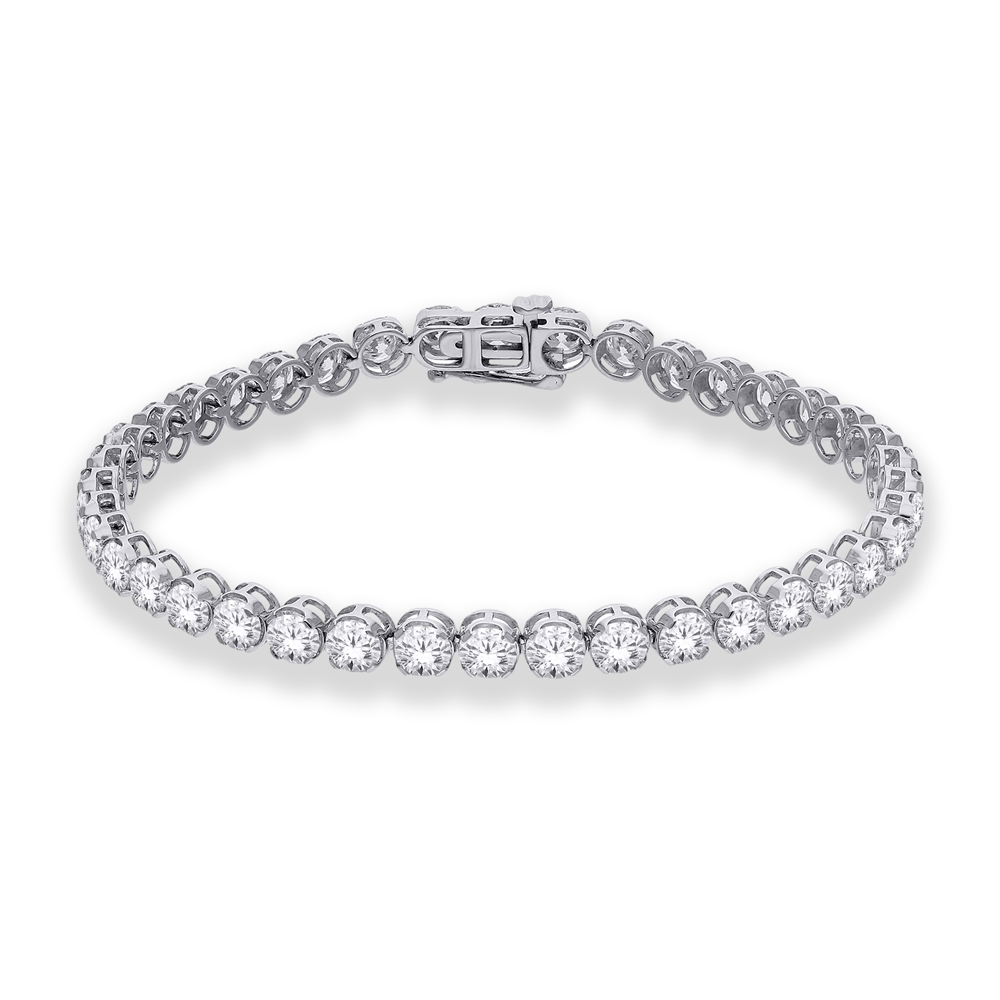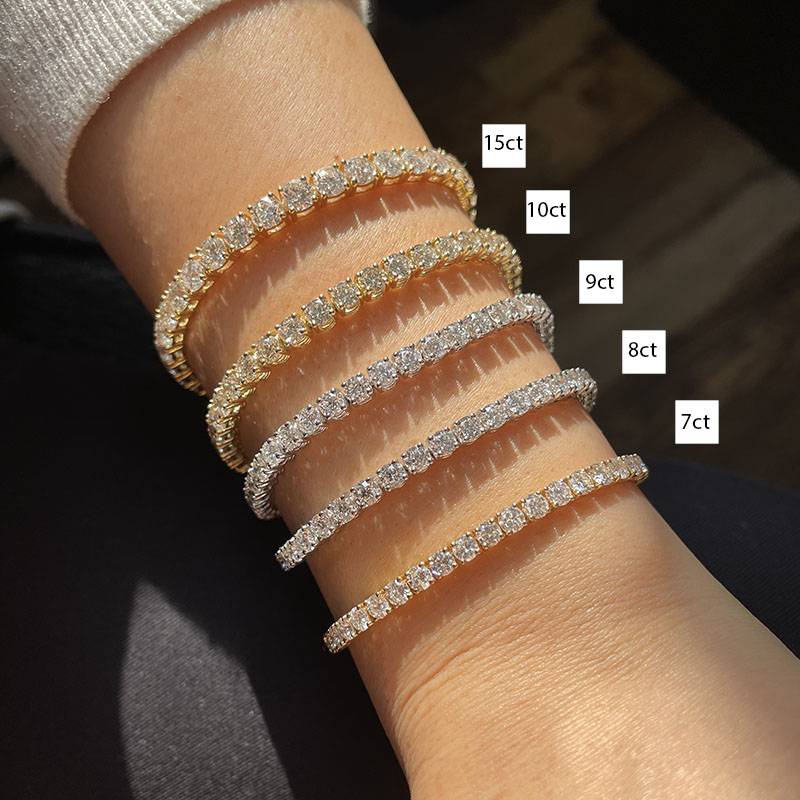The allure of diamonds has captivated humanity for millennia, symbolizing eternal love, luxury, and unwavering brilliance. For centuries, these precious stones, born from the colossal pressures deep within the Earth, have adorned royalty and celebrated life’s most significant milestones. However, the modern era has ushered in a remarkable innovation: the lab-grown diamond. These marvels of science offer all the breathtaking beauty and physical characteristics of their mined counterparts, but with a compelling narrative of ethical sourcing, environmental responsibility, and accessible luxury. Among the most sought-after expressions of this new wave of brilliance is the lab-grown diamond bracelet – a versatile, elegant, and conscious choice for the discerning individual.
The Genesis of Brilliance: Understanding Lab-Grown Diamonds
Before delving into the specific charm of a lab-grown diamond bracelet, it’s crucial to understand what lab-grown diamonds truly are. Far from being simulants or imitations like cubic zirconia or moissanite, lab-grown diamonds are real diamonds. They possess the identical chemical composition (pure carbon), crystal structure, optical properties, and physical characteristics as natural diamonds. The only difference lies in their origin: one is unearthed from the Earth, while the other is cultivated in a highly controlled laboratory environment.
Two primary methods facilitate the creation of these magnificent stones:
- High-Pressure/High-Temperature (HPHT): This method mimics the Earth’s natural diamond-growing conditions. A small diamond seed is placed in a growth chamber with carbon material and exposed to extreme heat (around 1,500°C) and pressure (about 70,000 atmospheres). Under these conditions, the carbon melts and crystallizes around the seed, forming a new diamond layer by layer.
- Chemical Vapor Deposition (CVD): In this process, a diamond seed is placed in a vacuum chamber, and carbon-rich gases (like methane) are introduced. Microwave energy then breaks down the gas molecules, allowing carbon atoms to rain down and bond to the seed, gradually forming a new diamond.
Both methods yield genuine diamonds that are indistinguishable from natural diamonds to the naked eye, and even to most gemologists without specialized equipment. They exhibit the same sparkle, fire, and scintillation that have made diamonds so revered, making them perfect candidates for exquisite jewelry, particularly bracelets.
Why Choose a Lab-Grown Diamond Bracelet? A Multifaceted Appeal
The decision to opt for a lab-grown diamond bracelet is driven by a powerful combination of ethical, environmental, economic, and aesthetic considerations, appealing to a contemporary consumer base that values both beauty and integrity.
-
Ethical Purity: Conflict-Free Assurance:
Perhaps the most compelling argument for lab-grown diamonds is their unimpeachable ethical provenance. The history of natural diamond mining has, at times, been marred by associations with conflict, human rights abuses, and exploitative labor practices, often referred to as "blood diamonds." While initiatives like the Kimberley Process have aimed to curb this, a completely transparent and untainted supply chain for all natural diamonds remains a complex challenge. Lab-grown diamonds, however, are created in controlled, traceable environments. Every stone can be tracked from its inception, guaranteeing a conflict-free origin and ensuring no human suffering is associated with its creation. This peace of mind is invaluable, allowing wearers to cherish their diamond bracelet without any underlying ethical concerns. -
Environmental Stewardship: A Lighter Footprint:
Diamond mining, by its very nature, is an intensive industrial process with significant environmental implications. It can lead to habitat destruction, soil erosion, water pollution, and substantial energy consumption. While efforts are being made to make mining more sustainable, the impact remains considerable. Lab-grown diamonds, in contrast, boast a significantly reduced environmental footprint. They require less land, consume fewer resources, and produce less waste. Many lab-growing facilities are also increasingly powered by renewable energy sources, further enhancing their eco-credentials. Choosing a lab-grown diamond bracelet is thus a statement of commitment to environmental preservation, aligning luxury with ecological responsibility. -
Exceptional Value: Uncompromised Quality at a Better Price:
Due to a shorter supply chain, no mining costs, and a more streamlined production process, lab-grown diamonds typically offer a more attractive price point compared to natural diamonds of equivalent size and quality. This means consumers can acquire a larger, higher-quality diamond bracelet for the same budget, or enjoy substantial savings on a piece they might otherwise find unaffordable. This accessibility to luxury allows more individuals to experience the joy of owning a stunning diamond bracelet, without compromising on the stone’s beauty or brilliance. The value proposition is clear: more sparkle for your investment, without sacrificing quality. -
Uncompromised Quality and Beauty: The 4Cs Apply:
Just like natural diamonds, lab-grown diamonds are graded according to the universally recognized "4Cs": Carat, Cut, Color, and Clarity. Reputable laboratories like the Gemological Institute of America (GIA), International Gemological Institute (IGI), and GCAL certify lab-grown diamonds, providing detailed reports that confirm their characteristics and authenticity. This ensures that a lab-grown diamond bracelet is not only beautiful but also holds verifiable quality. Wearers can be confident that their bracelet will possess the same mesmerizing sparkle, fire, and scintillation that natural diamonds are celebrated for. The visual and physical experience is identical. -
Modern Consciousness: Aligning with Contemporary Values:
Today’s consumers are increasingly conscious about where their products come from and the impact they have on the world. Lab-grown diamonds resonate deeply with this modern ethos. They represent innovation, transparency, and a forward-thinking approach to luxury. A lab-grown diamond bracelet is more than just a piece of jewelry; it’s a reflection of an individual’s values, a choice that speaks volumes about their commitment to a better, more responsible future.
The Art of Adornment: The Lab-Grown Diamond Bracelet
The bracelet, as a piece of jewelry, holds a unique place in personal adornment. It’s versatile, often worn daily, and can range from a subtle accent to a bold statement. When adorned with lab-grown diamonds, a bracelet transforms into an exquisite piece that catches the light with every movement, adding a touch of sophisticated glamour to any ensemble.
-
Versatility in Design: Lab-grown diamonds lend themselves perfectly to a myriad of bracelet styles.
- Tennis Bracelets: Perhaps the most iconic diamond bracelet style, a tennis bracelet features a continuous line of individually set diamonds. Lab-grown diamonds allow for a breathtaking display of uninterrupted sparkle, often enabling a higher total carat weight for a given budget, resulting in an even more dazzling effect.
- Bangles: Solid, rigid bracelets that can be worn individually or stacked, bangles often feature pavé-set diamonds or larger solitaires. Lab-grown diamonds can illuminate these designs with captivating brilliance.
- Charm Bracelets: While traditional charms are often metal, incorporating diamond-set charms can elevate a charm bracelet to a new level of luxury and personalization.
- Cuff Bracelets: Wider and more substantial, cuff bracelets provide a larger canvas for intricate diamond patterns or bold diamond clusters.
- Link Bracelets: Featuring interconnected links, these can be accented with diamonds in various settings, offering flexibility and comfort.
-
Customization and Personalization: The relative affordability of lab-grown diamonds opens up exciting possibilities for custom-designed bracelets. Individuals can work with jewelers to create unique pieces that perfectly reflect their style, incorporating specific diamond shapes, settings, and metal choices (white gold, yellow gold, rose gold, or platinum). Whether it’s a minimalist design with a single floating diamond or an elaborate art deco-inspired piece, lab-grown diamonds make bespoke luxury more attainable.
-
Everyday Elegance to Grand Occasions: A lab-grown diamond bracelet is not just for special events. Its durability and timeless appeal make it suitable for everyday wear, adding a touch of sparkle to casual outfits or elevating professional attire. For grand occasions, a more elaborate diamond bracelet can be the crowning jewel, perfectly complementing an evening gown and catching every eye.
Beyond the Sparkle: Addressing Common Questions
Despite their growing popularity, some questions and misconceptions about lab-grown diamonds persist.
- "Are they real diamonds?" Yes, unequivocally. As established, they are chemically, physically, and optically identical to natural diamonds. The term "real" refers to these intrinsic properties, not the origin.
- "Do they last as long as natural diamonds?" Absolutely. With a Mohs hardness rating of 10, lab-grown diamonds are just as durable as natural diamonds, making them perfect for jewelry meant to be worn and cherished for a lifetime, and even passed down through generations.
- "Do they have resale value?" Like all diamonds, natural or lab-grown, the primary value is in their beauty, symbolism, and personal enjoyment, rather than as a financial investment. The resale market for any diamond can be complex and often yields less than the initial purchase price. However, as the lab-grown market matures and gains wider acceptance, their intrinsic value and aesthetic appeal will remain constant.
- "How do I know it’s a lab-grown diamond?" Reputable jewelers will clearly disclose that a diamond is lab-grown. Furthermore, certified lab-grown diamonds come with grading reports from independent gemological laboratories (like IGI, GIA, GCAL) that explicitly state their origin. Many lab-grown diamonds are also laser-inscribed with a microscopic identifier on their girdle, visible under magnification, indicating their lab-grown status without affecting their beauty.
The Future is Bright: Market Trends and Sustainability
The trajectory for lab-grown diamonds is one of significant growth and increasing acceptance. Younger generations, in particular, are drawn to their ethical and sustainable credentials, making them a preferred choice for engagement rings, wedding bands, and indeed, bracelets. As technology advances, production costs may continue to decrease, further enhancing their accessibility without diminishing their quality or appeal.
The rise of lab-grown diamonds also signals a broader shift in the luxury market – one that prioritizes transparency, responsibility, and innovation. They are not merely an alternative but a legitimate, desirable choice that offers a compelling blend of tradition and modernity.
Conclusion: A Timeless Piece for the Modern Era
A lab-grown diamond bracelet is more than just a dazzling accessory; it is a profound statement. It represents a conscious choice for beauty that aligns with ethical values, environmental responsibility, and economic sensibility. It offers the same breathtaking sparkle and enduring quality as a natural diamond, but with a transparent origin story that brings peace of mind.
Whether chosen for its ethical purity, its reduced environmental impact, its exceptional value, or simply its undeniable brilliance, a lab-grown diamond bracelet is a symbol of modern luxury. It is a timeless piece of jewelry, imbued with the spirit of innovation and responsibility, ready to adorn and inspire for generations to come. In a world increasingly seeking meaning behind material possessions, the lab-grown diamond bracelet shines not just with light, but with integrity.


